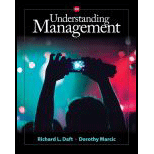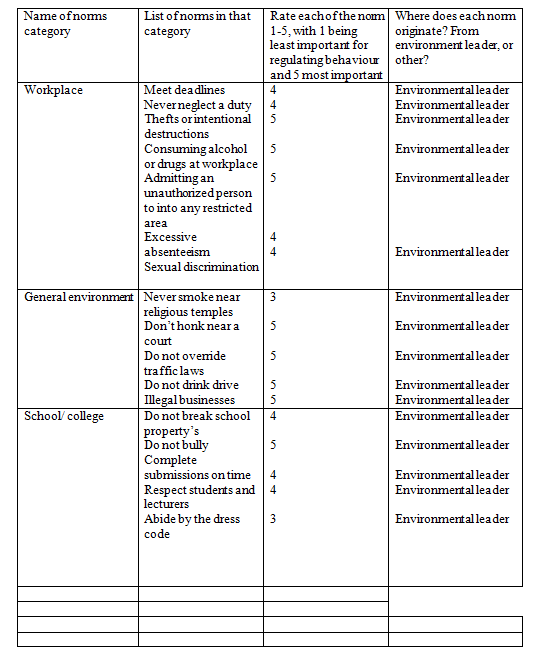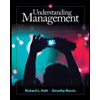
Understanding Management (MindTap Course List)
10th Edition
ISBN: 9781305502215
Author: Richard L. Daft, Dorothy Marcic
Publisher: Cengage Learning
expand_more
expand_more
format_list_bulleted
Question
Chapter 2, Problem 1GL
Summary Introduction
List of norms
Which group or organization is identified with this norm
What is the negative results if norm is violated
College writing should be in students own words or use special forms
In most of your courses
plagiarized
murder
In most of your courses
Death sentence
Meet the deadlines
Work environment
Chain of relationship will be broken
Intentional falsification, of personal records, payroll reports and etc.
Work environment
Suspension
Abusive,threatning or a coercive treatment of another employee
Work environment
Discharge
Theft as a treasurer
School clubs
Sacked out
Commitment and coordination into group work
School clubs
Warning or asking the team mate to leave the position
| List of norms | Which group or organization is identified with this norm | What is the negative results if norm is violated |
| College writing should be in students own words or use special forms | In most of your courses | plagiarized |
| murder | In most of your courses | Death sentence |
| Meet the deadlines | Work environment | Chain of relationship will be broken |
| Intentional falsification, of personal records, payroll reports and etc. | Work environment | Suspension |
| Abusive,threatning or a coercive treatment of another employee | Work environment | Discharge |
| Theft as a treasurer | School clubs | Sacked out |
| Commitment and coordination into group work | School clubs | Warning or asking the team mate to leave the position |

Expert Solution & Answer
Trending nowThis is a popular solution!

Students have asked these similar questions
what is knowledge-sharing initiatives and processes. What is ONE approach that would be beneficial in any organization, justifying how it would be of benefit to the business.
Honda emphasizes the importance of teamwork to ensure sustainability and success in the automotive industry. Teamwork was integrated into the organizational culture through continuous team-building training programs. However, when members of a group are deeply involved in a cohesive in-group and the desire for unanimity offsets their motivation to appraise alternative courses of action.
Explain 4 conditions that contribute to the development of such an issue.
Honda emphasizes the importance of teamwork to ensure sustainability and success in the automotive industry. Teamwork was integrated into the organizational culture through continuous team-building training programs. However, when members of a group are deeply involved in a cohesive in-group and the desire for unanimity offsets their motivation to appraise alternative courses of action.
Explain 4 conditions that contribute to the development of such an issue.
*organization behavior
Chapter 2 Solutions
Understanding Management (MindTap Course List)
Ch. 2 - Prob. 1OTJVCCh. 2 - Prob. 2OTJVCCh. 2 - Prob. 3OTJVCCh. 2 - Prob. 1DQCh. 2 - Prob. 2DQCh. 2 - Prob. 3DQCh. 2 - Prob. 4DQCh. 2 - Prob. 5DQCh. 2 - Prob. 6DQCh. 2 - Prob. 7DQ
Ch. 2 - Prob. 8DQCh. 2 - Prob. 9DQCh. 2 - Prob. 10DQCh. 2 - Prob. 1SLCh. 2 - Prob. 2SLCh. 2 - Prob. 3SLCh. 2 - Prob. 4SLCh. 2 - Prob. 5SLCh. 2 - Prob. 6SLCh. 2 - Prob. 7SLCh. 2 - Prob. 8SLCh. 2 - Prob. 9SLCh. 2 - Prob. 10SLCh. 2 - Prob. 1GLCh. 2 - Prob. 1ALCh. 2 - Prob. 2ALCh. 2 - Prob. 3ALCh. 2 - Prob. 4ALCh. 2 - Prob. 1EDCh. 2 - Prob. 2EDCh. 2 - Prob. 3EDCh. 2 - Prob. 1CFCACh. 2 - Prob. 2CFCACh. 2 - Prob. 3CFCA
Knowledge Booster
Similar questions
- GROUP LEARNING Current Events of an Unethical Type83 Step I. Prior to meeting as a group, each person should find two newspaper or magazine articles from the past several months relating to someone violating business ethics or potentially breaking the law regarding business practices. Step 2. Summarize the key points of the articles you found. Step 3. Meet as a group. Have each person share key points from articles with group members. Step 4. Identify similar themes across the unethical incidents reported in the articles. What was the source or underlying cause of the unethical behavior? What was the hoped—for outcome? Was an individual or a group involved? Did the accused seem repentant or defensive? Can you identify similar conditions of any kind across incidents? Write the common themes in a list on a sheet of paper or whiteboard. Step 5. What could you as a manager do to prevent such unethical behavior in your organization? What could you do to fix this kind of problem after it occurred in your organization? Step 6. Report your findings to the class if asked to do so by your instructor. Then fill in these boxes. Look at the underlying causes of the unethical behavior. How often was a group? How often an individual?arrow_forwardWhat are the advantages or disadvantages of the following for Apple as part of organization design globalization flexibility diversity delayering/ flat structuresarrow_forwardThis chapter discussed the role of values and beliefs in forming an organization’s culture. The topic of organizational culture is big business on the Internet. Many companies use their Web pages to describe their mission, vision, and corporate values and beliefs. There also are many consulting firms that advertise how they help organizations change their culture. The purpose of this exercise is for you to obtain information pertaining to the organizational culture for two different companies. You can go about this task by very simply searching the key words organizational culture or corporate vision and values. This search will identify numerous companies for you to use to answer the following questions. You may want to select companies that you would like to work for in the future. a. What are the espoused values and beliefs of the companies? b. Use the worksheet in Figure 3.6 to assess the Web page. What does the Web page reveal about the culture of this organization? Would…arrow_forward
- Explain Bensaou three management variables: 1- Information sharing practices; 2- Characteristics of ‘boundary-spanner’ jobs 3- The social climate within the relationship.arrow_forwardIn which ways can you promote a learning organization culture as a manager?arrow_forwardPlease agree/disagree and add more information regarding the below message (from a management perspective). "AI and machine learning have helped us come an extremely long way, especially in the business world. Because of AI, there has been huge improvement in areas such as the speed of business, customer service, reduction of error, and many other things that have improved the business setting. Today, AI has become so important that many businesses would fail without it. However, something that concerns me in regards to AI is the power that it has. In many instances, AI is a cheap form of labor. In the long run, paying a one time price for machines that will cut and create a business' clothing is much cheaper than paying laborers by the hour to do the same exact tasks. As a result, consumers would pay less for these goods, as the costs of production would be much lower. Besides laborers, AI also puts other workers in a position to be taken over within due time. Even now, we see…arrow_forward
- Commencing with a profound examination of organizational dynamics, illuminate the cardinal significance of feedback loops as catalysts for perpetual refinement and enhancement in the orchestration of organizational coordination across the expansive continuum of time, delving into the intricate interplay of iterative learning mechanisms, adaptive responses to dynamic contextual shifts, cultural assimilation, and strategic recalibration, thereby unraveling the multidimensional complexities intrinsic to fostering a culture of relentless evolution and seamless coordination amidst the ever-unfolding tapestry of organizational evolution.arrow_forwardWhat role does organizational culture play in promoting or hindering effective coordination?arrow_forwardWhy do you think learning systems evolved in this way? Is there still a place for group classroom training? What types of learning might require classroom training, and what is better suited for online and YouTube-style learning?arrow_forward
- Mangement Organizational culture refers to the shared values, beliefs, norms, and behaviors that characterize an organization. It plays a crucial role in shaping employee attitudes and behaviors, influencing decision-making processes, and ultimately driving organizational performance. A strong and positive organizational culture fosters employee engagement, creativity, and collaboration, leading to higher levels of productivity and innovation. It also helps attract and retain top talent, as employees are drawn to organizations with cultures that align with their own values and beliefs However, managing and nurturing a healthy organizational culture requires ongoing effort and commitment from leaders at all levels of the organization. Question: How can managers effectively assess and understand the current organizational culture to identify areas for improvement and ensure alignment with the organization's goals and values?arrow_forwardTASK 1: What is Cooperative Enterprise from the Caribbean Management Training Programmes. Create a concept Map about cooperatives. 1. Create a concept map about cooperatives using the information you gathered while reading the first reading material in this module. 2. Explain the content of your concept map. Express your thoughts in 200-300 words and indicate the total word count. Use the format below in the imagearrow_forwardWhat organizational theories that are discussed in the article Organizational Learning and Communities of Practice Toward a Unified View of Working, Learning, and Innovation by by John Seely Brown and Paul Duguidarrow_forward
arrow_back_ios
SEE MORE QUESTIONS
arrow_forward_ios
Recommended textbooks for you
 Understanding Management (MindTap Course List)ManagementISBN:9781305502215Author:Richard L. Daft, Dorothy MarcicPublisher:Cengage Learning
Understanding Management (MindTap Course List)ManagementISBN:9781305502215Author:Richard L. Daft, Dorothy MarcicPublisher:Cengage Learning Management, Loose-Leaf VersionManagementISBN:9781305969308Author:Richard L. DaftPublisher:South-Western College Pub
Management, Loose-Leaf VersionManagementISBN:9781305969308Author:Richard L. DaftPublisher:South-Western College Pub

Understanding Management (MindTap Course List)
Management
ISBN:9781305502215
Author:Richard L. Daft, Dorothy Marcic
Publisher:Cengage Learning

Management, Loose-Leaf Version
Management
ISBN:9781305969308
Author:Richard L. Daft
Publisher:South-Western College Pub
